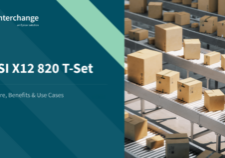Consumer Expectations cause Demand for Integrated Data
With the advancement in technology as well as data analytics over the past few years, businesses have been able to customise like never before. This customisation, through the use of integrated data, has increased buyer expectations and is a trend that is continuing to advance.
With your customers expected to deliver a tailored experience to their customers, in this article we bring to you an example of how you can help your customers succeed in impressing theirs. All whilst bringing a plethora of benefits to your business!
Consumer expectations are at an all-time high
66% of customers expect companies to understand their needs and expectations¹. With consumer expectations continually growing, businesses across the globe are either trying to meet these or are playing catch up with their competition to ensure they don’t get left behind.
This trend leads to a cycle of businesses needing to invest in digital transformation. By doing so, they can access and analyse their data, understand their customers on a deeper level, and increase their personalisation.
88% of customers expect companies to accelerate digital initiatives due to COVID-19¹. It is clear that the pandemic has only enhanced this expectation and has caused more businesses to act faster than initially anticipated.
Suggested reading: To find out more take a look at the article Post-Pandemic Supply Chain Challenges Increase the Pressure
Why do your customers need to know their customers?
All businesses that sell a physical product will be involved with a supply chain. Coupled with the supply chain management market set to grow considerably⁴, it is fair to say that your customers will be involved in supply chains and have the potential to grow. In addition to this, you have the opportunity to be involved in the predicted supply chain management market growth. So, let’s dig a little into how you can achieve this.
To be able to provide a sophisticated experience to their customers, your customers will need the ability to see, track and report on their business data. They will require end-to-end visibility, forecasting and planning capabilities.
By having integrated data through the use of electronic data interchange (EDI) your customers will be able to gain visibility of key document movements within their supply chain(s) and forecast.
The challenges your customers face
Within the supply chain, it is imperative that there is no disruption to the supply of parts and materials. Disruptions cause many issues, such as:
- Delays
- Missed deadlines
- Unhappy customers
- Financial losses and penalties
With production line stoppages costing hundreds of thousands of pounds per hour⁵, having reliable and accurate forecast information is imperative to keeping the supply chain running and ensuring that your customers can deliver on their customers’ expectations. The exchange of documents via electronic data interchange (EDI) and integrating this data directly into your customers’ manufacturing and ERP systems makes this possible.
Simplify your customers’ tech stack
Offering integration enables trading partners to exchange data with each other. However, having EDI compliments your ERP solutions because it not only enables you to integrate your customers’ systems but provides the capability to exchange industry-standard documents and meet the requirements of your customers trading relationships.
Without this offering, your customers would need to go to third parties leaving them with a complex tech stack that is difficult to manage and frustrates your customers. Ideally having an ERP with built-in EDI capabilities allows you to make your customers a compelling offer.
The challenges that Data Integration brings
As with everything, it is easy enough to say go and get these capabilities and it will all be fine. But implementing data integration to provide those capabilities mentioned above, of course, comes with its associated challenges:
- Ensuring data is available in real-time
- Eradicating data silos
- Building smart architecture
- Data security
- Meeting project deadlines
- Keeping up with trends
Suggested reading: Find out more in this blog: B2B Integration Challenges
Expand your ERP data integration portfolio
Don’t just offer a stand-alone ERP. With the big ERP players, such as SAP³, offering some sort of data integration, it is the way forward.
Over 80% of enterprise Business Operations leaders say data integration is critical to ongoing operations². It’s apparent that the need for integrated data is prevalent across industries, so there is scope for ERP businesses to expand into this area or widen their breadth of offering within the space.
This need for integrated data is here to stay as it provides a base on which your customers can build on moving forwards. This is why it is key that they put the time and effort into this now rather than later. 67% of enterprises are relying on data integration to support analytics and BI platforms today, and 24% are planning to in the next 12 months². So, having a solid data integration setup has the potential to provide your customers with everything they need to remain competitive now and in the future.
Work with an expert who can support you with those data integration challenges so you can offer your customers an end-to-end data integration solution from someone they can trust.
Enable your customers via EDI
Help your customers overcome some of the above-mentioned data integration challenges by offering them EDI as a part of your end-to-end solution.
65% of organizations prefer to deploy data integration solutions from cloud platforms or hybrid cloud.²
With the pandemic accelerating digital transformation in the supply chain arena⁶, now is the perfect time for ERP customers to be re-evaluating their tech-stack. Whether they are looking to move to the cloud and have an upcoming project or not, it’s time to help them gear up to meet their customers’ expectations by widening their vision.
EDI-as-a-Service combines cloud-based and on-demand/optional managed services to seamlessly merge multiple types of EDI and accommodate the full spectrum of EDI standards and protocols. The outcome is an end-to-end EDI solution that’s able to match the demands of complex global supply chains, regardless of your EDI expertise.
At Data Interchange, we’ve pioneered this agile approach to EDI so you can offer your customers next-level data integration services.
Suggested reading: Download our eBook: How to Deliver Next-Level Integration Services to find out more
The benefits your customers will gain from EDI Data Integration
- Availability of real-time integrated data
- Data visibility
- Improved partnerships and customer relationships
- Saves time
- Boosts efficiency
- Reduces errors
- Decreased fines
- Informed business decisions
And much more…Suggested reading: Supply Chain Flexibility: Why your customers need it
What you will gain
- Grow and Retain your customers
- Increase your revenue
- Lower your churn rate, thus increasing stability
- Improve customer satisfaction
Provide your customers with integrated data solutions. This will enable them to personalise their customers’ experience and meet the demands of the future.
Suggested viewing: QAD Case Study video: An ERP Business
¹Salesforce: What Are Customer Expectations, and How Have They Changed? ²Forbes: The State Of Enterprise Data Integration, 2020 ³SAP Data Services ⁴Statista: Size of the global supply chain management market worldwide from 2020 to 2026 ⁵IOSH magazine: PRODUCTION LINE FAILURES ⁶Data Interchange: Post-Pandemic Supply Chain Challenges Increase the Pressure





























































































































